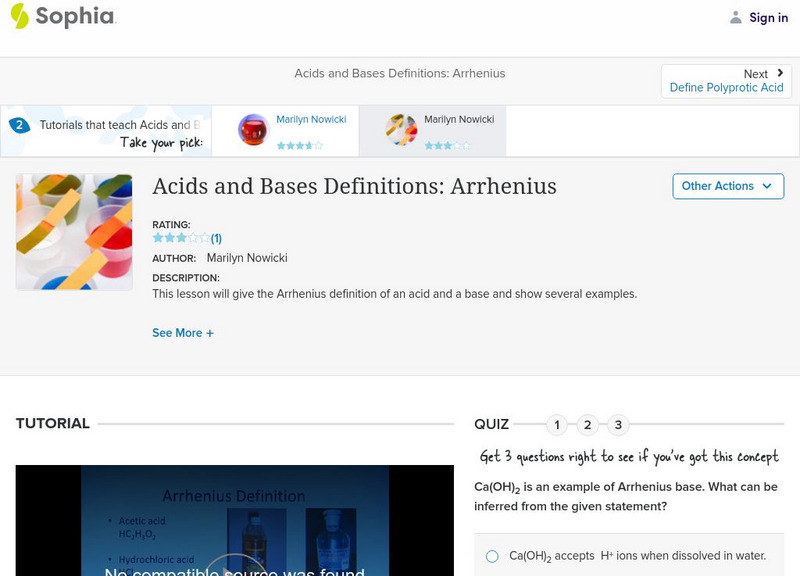Khan Academy
Khan Academy: Autoionization of Water
Autoionization of water into hydronium and hydroxide ions.
Khan Academy
Khan Academy: Biology Foundations: Introduction to P H
Introduction to the concept of pH. [5:21]
Khan Academy
Khan Academy: Buffers and Henderson Hasselbalch
A buffer solution contains a mixture of a weak acid and its conjugate base (or a weak base and its conjugate acid). The equilibrium between the weak acid and its conjugate base allows the solution to resist changes to pH when small...
Khan Academy
Khan Academy: Acid and Base Catalyzed Hydrolysis of Amides
This video explains the mechanisms for acid and base-catalyzed hydrolysis of amides. [11:46]
Khan Academy
Khan Academy: Acid and Base Catalyzed Formation of Hydrates and Hemiacetals
This video demonstrates how the addition of acid or base can catalyze the formation of hydrates and hemiacetals. [10:26]
Khan Academy
Khan Academy: Titration Calculation Example
Learn how to calculate the unknown concentration with titration. See an example of titrating strong acid, hydrochloric acid, with strong base barium hydroxide. [7:49]
Sophia Learning
Sophia: Define Polyprotic Acid: Lesson 2
This lesson will define a polyprotic acid and compare that to a monoprotic acid. It is 2 of 2 in the series titled "Define Polyprotic Acid."
Sophia Learning
Sophia: What Is P H?: Lesson 1
This lesson will explain what pH means, and the difference between substances with a high pH vs a low pH. It is 1 of 4 in the series titled "What is pH?"
Sophia Learning
Sophia: Acid/base Titration Calculations: Lesson 2
This lesson will demonstrate how to calculate the concentration of an unknown (acid or base) using the information obtained from a titration. It is 2 of 2 in the series titled "Acid/Base Titration Calculations."
Sophia Learning
Sophia: Acid/base Titration Curve: Lesson 2
This lesson will explain the regions of a titration curve and what they represent. It is 2 of 2 in the series titled "Acid/Base Titration Curve."
Sophia Learning
Sophia: Acid/base Titration Curve: Lesson 1
This lesson will explain the regions of a titration curve and what they represent. It is 1 of 2 in the series titled "Acid/Base Titration Curve."
Sophia Learning
Sophia: Acid/base Titrations Definitions: Lesson 2
This lesson will define the vocabulary of an acid/base titration - endpoint/equivalence point, titrant, indicator, and sample. It is 2 of 2 in the series titled "Acid/Base Titrations - Definitions."
Sophia Learning
Sophia: Acid/base Titrations Definitions: Lesson 1
This lesson will define the vocabulary of an acid/base titration - endpoint/equivalence point, titrant, indicator, and sample. It is 1 of 2 in the series titled "Acid/Base Titrations - Definitions."
Sophia Learning
Sophia: Acids and Bases Definitions: Arrhenius: Lesson 2
This lesson will give the Arrhenius definition of an acid and a base and show several examples. It is 2 of 2 in the series titled "Acids and Bases Definitions: Arrhenius."
Sophia Learning
Sophia: Acids and Bases Definitions: Bronsted Lowry: Lesson 2
This lesson will give the Bronsted-Lowry definition of an acid and a base and show several examples. It is 2 of 2 in the series titled "Acids and Bases Definitions: Bronsted-Lowry."
Sophia Learning
Sophia: Acids: Defining Binary Acids: Lesson 2
This lesson will define an acid and give examples. It is 2 of 2 in the series titled "Acids: Defining Binary Acids."
Sophia Learning
Sophia: Acids: Defining Binary Acids: Lesson 1
This lesson will define an acid and give examples. It is 1 of 2 in the series titled "Acids: Defining Binary Acids."
Sophia Learning
Sophia: Calculating [H+]: Lesson 1
This lesson will demonstrate how to calculate the H+ concentration given the pH of a solution. It is 1 of 2 in the series titled "Calculating [H+]". [4:30]
Sophia Learning
Sophia: Calculating P Oh: Lesson 2
This lesson will demonstrate how to calculate the pOH of a solution knowing the total of both pH and pOH is 14. It is 2 of 2 in the series titled "Calculating pOH."
Sophia Learning
Sophia: Chemical Reaction Types: Acid Base: Lesson 1
This lesson will show that the products of an acid base reaction are water and a salt. It is 1 of 2 in the series titled "Chemical Reaction Types: Acid-Base."

















![Sophia: Calculating [H+]: Lesson 1 Instructional Video Sophia: Calculating [H+]: Lesson 1 Instructional Video](https://content.lessonplanet.com/knovation/original/153160-b95897d8b1cadeb6aa7db092e19f0ab3.jpg?1661759515)

